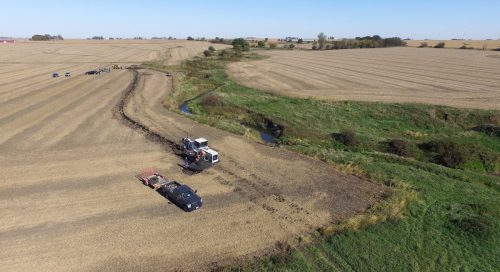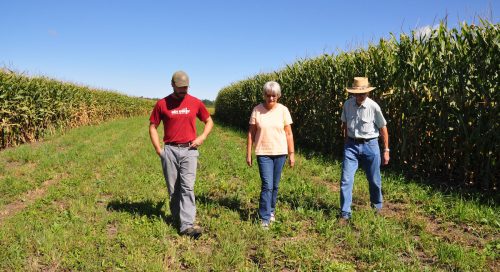One of the questions often asked about the Agricultural Conservation Planning Framework, better known as ACPF, is how to use it if you don’t have much background in GIS. Here are some things you should know that could help jump-start your ACPF journey.
But first, what is ACPF?
In terms of its use to watershed professionals, ACPF is a data-driven approach to making strategic decisions about how and where to implement agricultural conservation practices, such as terraces or buffer strips, on farms to improve water quality in watersheds at the HUC 12 scale. It helps increase the efficiency and effectiveness of working with farmers and landowners to meet goals within a watershed management plan by providing a menu of options that can open up the conversation.
A geospatial “toolbox,” ACPF has inputs and outputs. Data such as land use, elevation, and soil type go into ACPF. Maps dotted with recommendations for where conservation practices would make sense on the landscape come out.
“It paints a holistic picture of where practices could go in the first steps of the conservation planning process, enabling planners to see the broader context for how to make a positive impact in their watershed,” said Hanna Bates, acting assistant director of the Iowa Water Center at Iowa State University who is part of a research team focused on social dimensions of ACPF.
Each “tool” in the ACPF toolbox is essentially a layer of computer code that represents a specific conservation practice. Using ArcGIS software, a user can run tools of interest with their watershed’s data to understand the best places for those practices.
“We’re providing conservation practice suggestions based on an actual field and a particular spot in that field,” said Robin McNeely, GIS facility manager at Iowa State University who is on the ACPF development team. “It opens up possibilities that [users] may not have thought about.”
Having GIS chops is advantageous on the output generation side of ACPF, which is the first of two “user pathways” for the toolbox. The other pathway is the interpretation of the outputs and the subsequent collaboration with farmers and farming communities to pinpoint actual practice placement based on real-life farmer preferences and constraints.
“We don’t want the hands-on piece and output data to be something that will hold people back,” said McNeely.
So even if you don’t know how to do GIS magic, here are three things to know about ACPF that may help you overcome hesitation in using it to develop and implement watershed management plans.
Baked-in Standards
ACPF is science based, and its tools are programmed with defaults that reflect guidelines from the USDA Natural Resources Conservation Service (NRCS) regarding how to implement conservation practices. This means the standard recommendations ACPF would generate for your watershed are based on the best available data and adhere to NRCS specifications.
Even though those recommendations are general, they are legitimate for then working with farmers to tailor them to their operations.
The value of having GIS expertise is the ability to customize settings within the tools to generate outputs that are more specific to local needs and circumstances, such as minimum requirements for terrace lengths, which can vary. In a sense, the difference is in when customization happens – on the programming end or the application end.
Read the Manual
While not the most profound piece of advice, taking advantage of the robust library of resources on how to navigate ACPF really could save you time and headache. But don’t take my word for it.
Yaw Kwarteng is a graduate student at Iowa State University who helped the ACPF development team “pre-process” watershed maps for the toolbox, meaning he made sure the stream networks on the maps match with reality. He started this work with only a couple of introductory GIS classes under his belt, and he said the user’s manual helped a lot.
Meanwhile, fellow pre-processor and undergraduate student Thomas Kosacz, who also jumped into the project with “little to no” GIS experience and got somewhat overwhelmed by the manual’s length, headed to the tutorials on YouTube instead.
There is also a newly released free online course that guides users through setting up and running ACPF step by step.
Just Jump In
And then there is the learning-by-doing approach, which both Kwarteng and Kosacz promoted.
“You definitely learn a lot more by using the tool than just listening or reading about it,” said Kosacz.
What helped make things click for Kosacz was making mistakes. Just by tinkering with the tools, he said he was able to get a better grasp of remote sensing and how to use GIS data than he even got in his GIS courses.
“I learned a lot about the farms,” chuckled Kwarteng, who came to Iowa from Ghana. “Now when I see farms, I understand what they’re doing.”
“What a beginning GIS user will find is it’s an iterative process,” said McNeely, who was Kosazc and Kwarteng’s mentor on their ACPF work.
And if you just don’t have the desire to try your hand at GIS and can’t find a colleague or collaborator with GIS experience, McNeely half-jokingly remarked her team would be happy to run the tools for you (for a small sum).
Header photo courtesy NRCS/SWCS, taken by Lynn Betts



